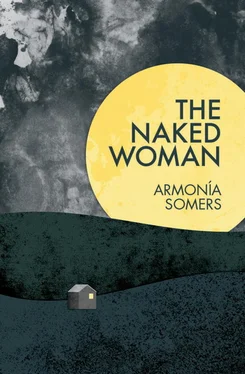Armonía Somers - The Naked Woman
Здесь есть возможность читать онлайн «Armonía Somers - The Naked Woman» весь текст электронной книги совершенно бесплатно (целиком полную версию без сокращений). В некоторых случаях можно слушать аудио, скачать через торрент в формате fb2 и присутствует краткое содержание. Город: New York, Год выпуска: 2018, ISBN: 2018, Издательство: The Feminist Press, Жанр: Современная проза, на английском языке. Описание произведения, (предисловие) а так же отзывы посетителей доступны на портале библиотеки ЛибКат.
- Название:The Naked Woman
- Автор:
- Издательство:The Feminist Press
- Жанр:
- Год:2018
- Город:New York
- ISBN:978-1-93-693-244-3
- Рейтинг книги:5 / 5. Голосов: 1
-
Избранное:Добавить в избранное
- Отзывы:
-
Ваша оценка:
- 100
- 1
- 2
- 3
- 4
- 5
The Naked Woman: краткое содержание, описание и аннотация
Предлагаем к чтению аннотацию, описание, краткое содержание или предисловие (зависит от того, что написал сам автор книги «The Naked Woman»). Если вы не нашли необходимую информацию о книге — напишите в комментариях, мы постараемся отыскать её.
The Naked Woman — читать онлайн бесплатно полную книгу (весь текст) целиком
Ниже представлен текст книги, разбитый по страницам. Система сохранения места последней прочитанной страницы, позволяет с удобством читать онлайн бесплатно книгу «The Naked Woman», без необходимости каждый раз заново искать на чём Вы остановились. Поставьте закладку, и сможете в любой момент перейти на страницу, на которой закончили чтение.
Интервал:
Закладка:
The foremost Uruguayan literary critic, Ángel Rama, considered Somers’s novels and short stories part of a “secret cult among Uruguayan writers” because she joined a small group of writers who did not follow the literary trends of their epoch. [7] Dalmagro 2009, 95.
Her controversial plots and baroque style led critics to call Somers a “strange writer,” even among marginal authors from the “critical generation,” or “the generation of ’45,” as Rama termed authors who appeared on the literary scene between 1939 and 1969, before the rise of the dictatorship. [8] Rama 1972.
The critical generation, explains Rama, had a common agenda: to rebuild the cultural values of the modern Uruguayan nation. At that time, novelists such as Mario Levrero, Juan Carlos Onetti, and Mario Benedetti took the lead.
In the fifties, however, women writers were not easily heard within this cultural and political debate until they started publishing works with a radical aesthetic in which gender and genre collided: that is to say, when they took to writing fiction in order to talk more candidly about womanhood without the ordinary restraints imposed by male intellectuals, often their own husbands. [9] María Rosa Olivera-Williams (2012) explains how the fifties was a crucial moment for women writers, as they started to negotiate what a “feminine” subjectivity and “feminine writer” was going to be, as most of them were married to male writers.
One such author, from middle-class origins, was Paulina Medeiros, who published Las que llegaron después in 1940. Echoing the title, Rama said in regard to those authors not included in the generation of ’45:
Those who arrived later are women, who gained civil and human agency in this new society which they will speak of with fierce criticism—sometimes too rigid, sometimes cynical, always nonconformist—reformulating with more boldness than men those problems related to affectivity, and in particular, those of sexuality. [10] Rama, 97 (translation my own). “Las que llegaron después son las mujeres, quienes alcanzan autonomía civil y humana en esta nueva sociedad de la que se han de expresar con violentas críticas, a veces esquemáticas, a veces cínicas, siempre inconformistas, replanteando con más audacia que los hombres los problemas de la afectividad y en particular los de las relaciones sexuales.”
While Rama acknowledges women writers’ contributions to the arts, he still considers them secondary, when in fact they started writing and publishing in the early forties and fifties, to be acknowledged only twenty years later. [11] While these women writers started publishing with a disruptive aesthetic in the early twentieth century, they weren’t recognized until the late sixties, when women’s rights movements around the world inspired a critical perspective on women’s writing. For instance, by the time Somers published her first novel, Simone de Beauvoir had just published Le Deuxième Sexe in 1949. It’s worth noting how writers such as Mexican authors Elena Garro and Rosario Castellanos were writing on the margins in the sixties, too, while Argentinian Silvina Ocampo and her sister Victoria Ocampo published the influential literary magazine Sur in Buenos Aires in the 1930s. Mexico, Argentina, and Uruguay, however, were considered the most advanced Latin American countries in terms of women’s rights, while women writers from other countries in the region were kept in the shadows until the late eighties and nineties. For a detailed genealogy of female authorship in the twentieth century, see Olivera-Williams 1991 and 2012.
Disregarding this blatant sexism, Uruguayan women writers didn’t conform to establishment literary approaches; they took their marginalization as an opportunity to write about a different sensibility, more committed to an aesthetic of freedom in which a mix of traditional and new genres created a unique style. Understandably then, when asked about her relationship to her critical generation peers, Somers was always reluctant to be confined by such a label:
I feel no ties with the generation I ought to be part of. I believe that apart from the usual generations, the literary ones are not only chronological but also imply a certain homogeneity of form, motivation, semantics, and even in ideology, that separates them from previous or future generations. In my case (not because I feel superior of inferior, but rather different) I do not consider myself to be part of the generation that they usually call mine. [12] Picon Garfield, 38.
Alongside Somers, Uruguayan women writers such as Clara Silva ( La sobreviviente 1953), Cristina Peri Rossi ( Los museos abandonados 1969), Teresa Porzecanski ( El acertijo y otros cuentos 1967), and Mercedes Rein ( Zoologismos 1967) also constructed this aesthetic of difference and formed a diverse group that slowly brought this generation of women authors into the public sphere. Some of them, such as Peri Rossi, were even forced into exile after being persecuted by Uruguay’s dictatorship. Interestingly, however, when The Naked Woman was published in 1950, readers could not believe it had been written by a woman. Somers had a clear explanation for their skepticism:
They say [Somers’s writing] has a certain strength, a virility, a valor that a woman usually doesn’t express due to ancestral prejudices which are of no consequence to me. I believe it’s good for women to gather, for women writers to assemble at conferences if they are going to discuss literature and not other problems. Besides, that spreads the news about our literature, which we ought to do since men are more prominent. [13] Picon Garfield, 48.
Despite those initial doubts, today The Naked Woman is understood to have been groundbreaking, as its publication would bring down literary and cultural boundaries for women writers in the years that followed. [14] According to Ángel Rama (1972), certain upper-class women writers from the Southern Cone, such as Silvina Ocampo from Argentina and Clarice Lispector from Brazil, were often included in “official” literary circuits, and their writings had been canonically considered avant-garde. Somers’s work, however, remained marginalized for a long time.
When The Naked Woman was serialized in two issues of Clima, a literary magazine, and later formally published as a book in 1951 and 1966, it caused significant upheaval in the Uruguayan literary scene. In interviews, Somers confessed that she would attend book clubs, hidden behind her pen name, just to witness readers suggesting that the book had been written by a man, a heterosexual couple, or a group of writers. They couldn’t fathom, Somers remembered, that it was a woman who “dared to skip stones in calm waters.” [15] Risso, 254.
As time passed, “modest Montevideo grew up and accepted the novel. Now that The Naked Woman is a legal citizen [of the Uruguayan literary community] there will be no further editions,” Somers observed. [16] Gandolfo 1986 (translation my own). “Entretanto la púdica Montevideo creció y lo aceptó. Y ahora que La mujer desnuda es ciudadana legal no hay reediciones.”
She didn’t anticipate the future success of her book nor the posthumous Spanish edition in 2009.
It comes as no surprise that The Naked Woman continues to find new fans among readers today. This is the kind of book we want to read at night, far from noisy distractions, engulfed in silence, so that we are able to hear the voice emerging from the story. Eventually, the dark night herself becomes an eloquent narrator, confessing her lack of words to express what she is feeling and seeing. It is also the darkness of night that protects the Naked Woman throughout her journey, whereas daylight strips her of her power.
Читать дальшеИнтервал:
Закладка:
Похожие книги на «The Naked Woman»
Представляем Вашему вниманию похожие книги на «The Naked Woman» списком для выбора. Мы отобрали схожую по названию и смыслу литературу в надежде предоставить читателям больше вариантов отыскать новые, интересные, ещё непрочитанные произведения.
Обсуждение, отзывы о книге «The Naked Woman» и просто собственные мнения читателей. Оставьте ваши комментарии, напишите, что Вы думаете о произведении, его смысле или главных героях. Укажите что конкретно понравилось, а что нет, и почему Вы так считаете.











